
| JAPANESE | TOP PAGE | ||||
|---|---|---|---|---|---|
| 1 | 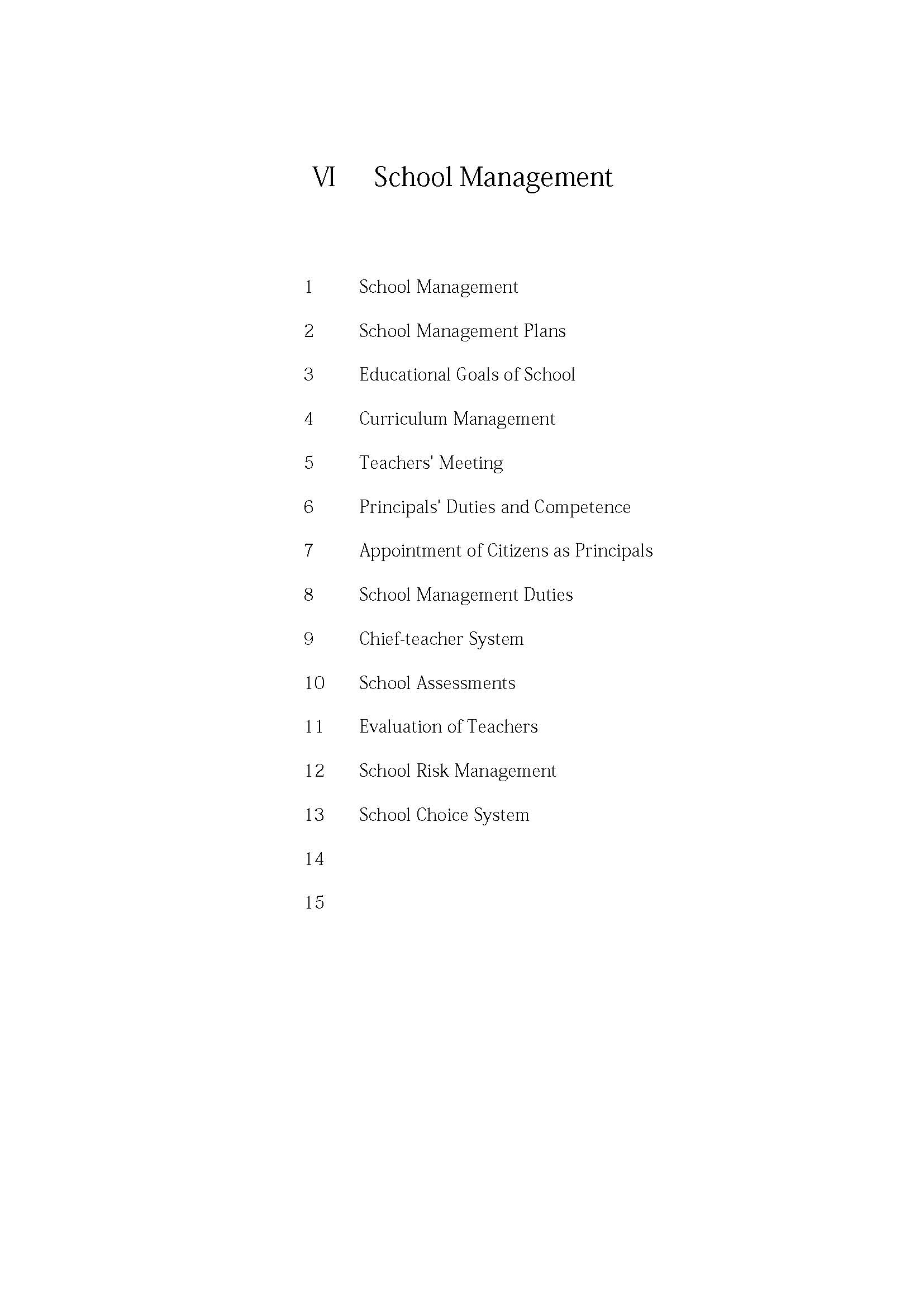 |
Download : 6. School Management | |||
| 2 | 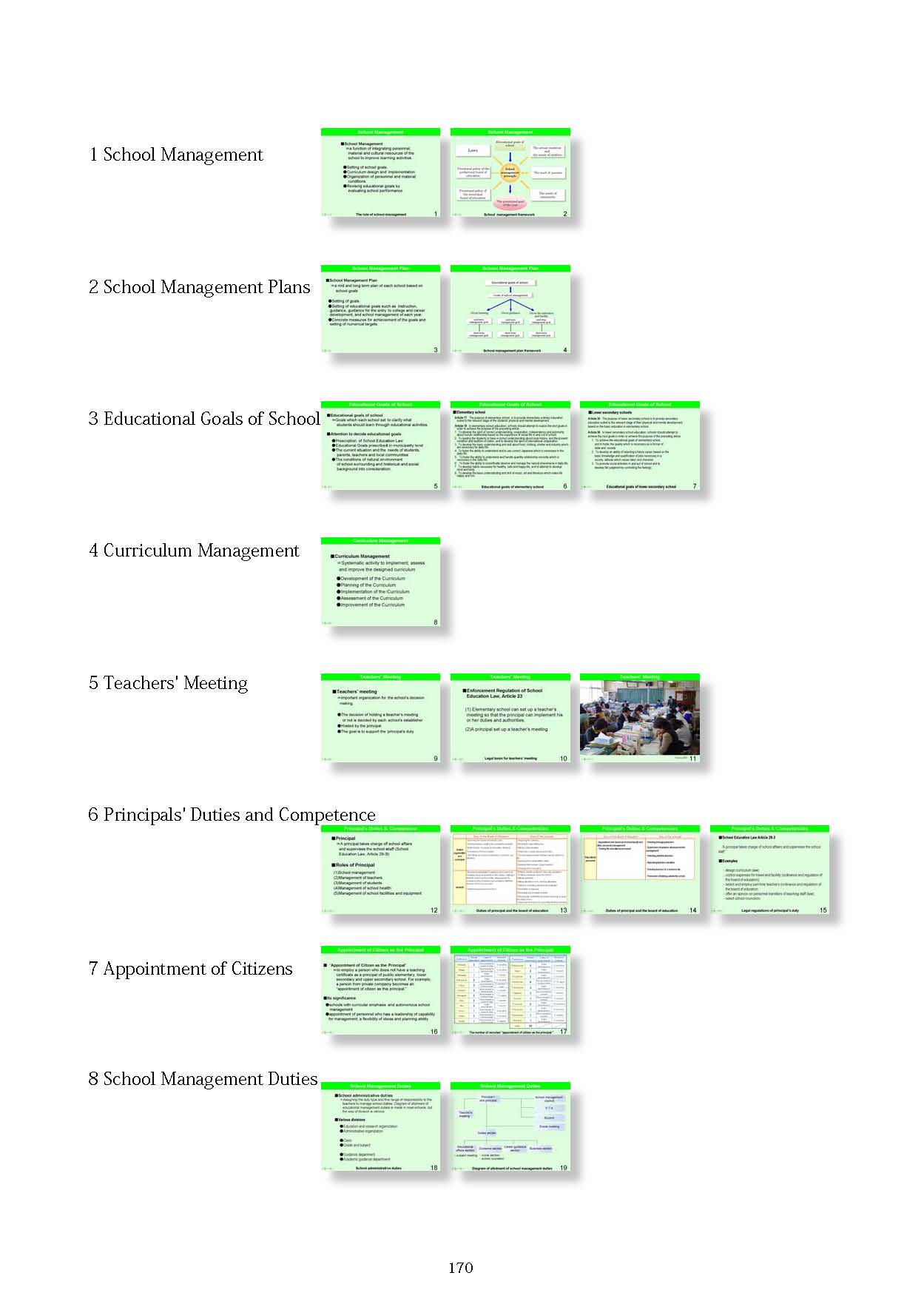 |
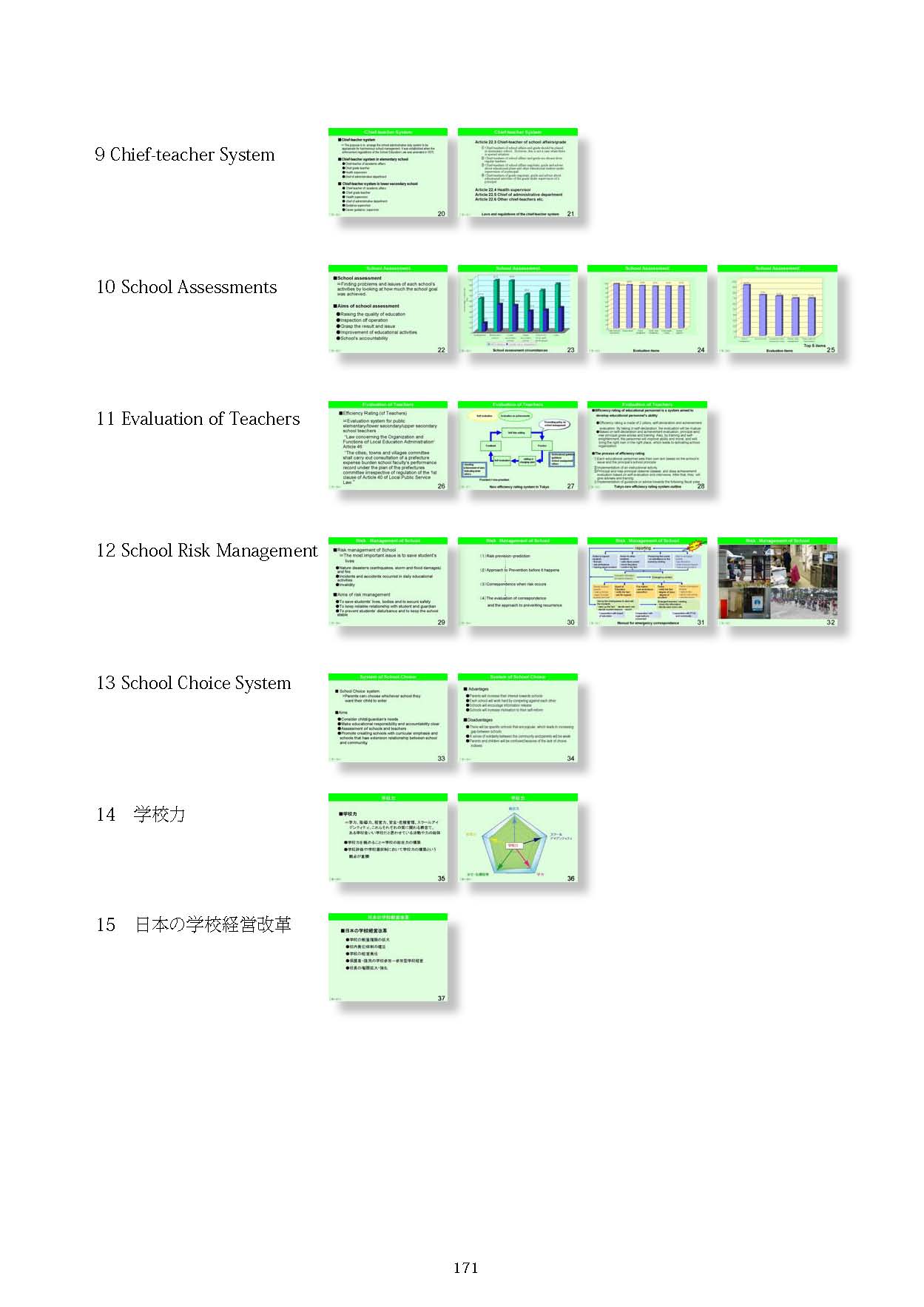 |
3 | ||
| 4 | School management focuses on the importance of school stakeholders’ autonomous use of creativity in management. School stakeholders make decisions about personnel and material aspects such as setting educational goals and curriculum design. They give shape to the educational goals. | 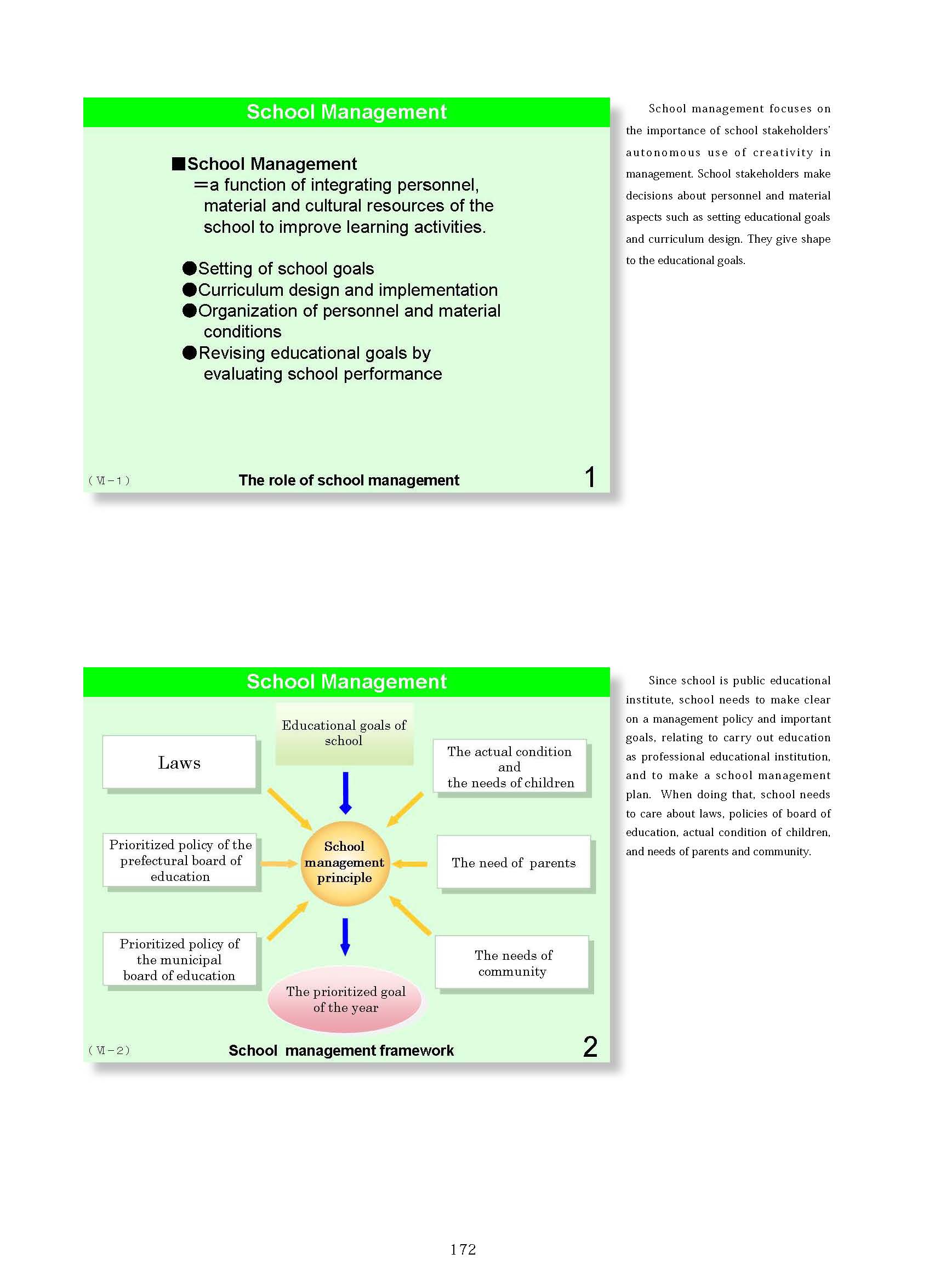 |
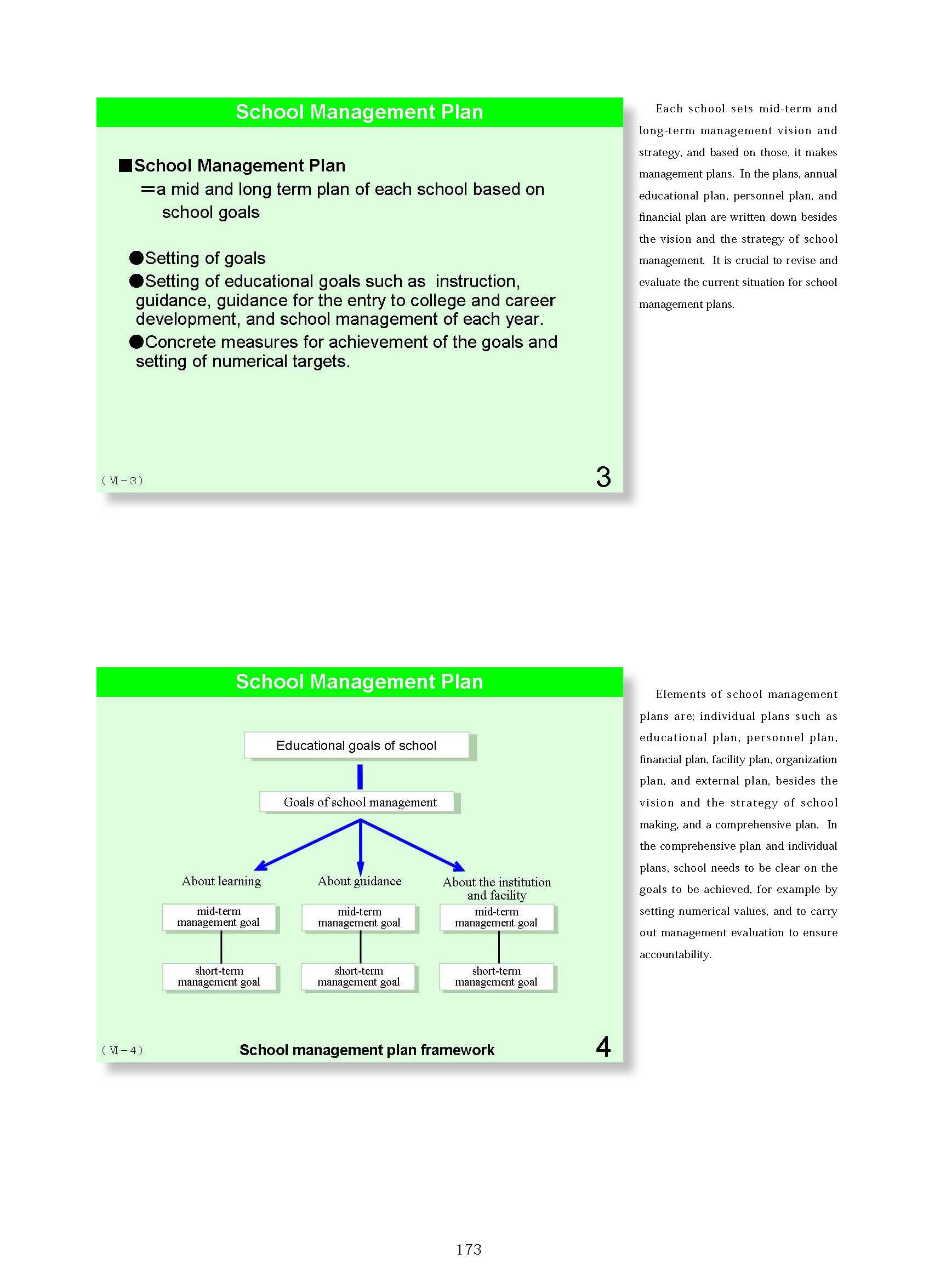 |
Each school sets mid-term and long-term management vision and strategy, and based on those, it makes management plans. In the plans, annual educational plan, personnel plan, and financial plan are written down besides the vision and the strategy of school management. It is crucial to revise and evaluate the current situation for school management plans. | 5 |
| Since school is public educational institute, school needs to make clear on a management policy and important goals, relating to carry out education as professional educational institution, and to make a school management plan. When doing that, school needs to care about laws, policies of board of education, actual condition of children, and needs of parents and community. | Elements of school management plans are; individual plans such as educational plan, personnel plan, financial plan, facility plan, organization plan, and external plan, besides the vision and the strategy of school making, and a comprehensive plan. In the comprehensive plan and individual plans, school needs to be clear on the goals to be achieved, for example by setting numerical values, and to carry out management evaluation to ensure accountability. | ||||
| 6 |
Each school needs to develop education and management based on public education goals described in laws and the course of study by the state. Educational goals set by the state are defined in the School Education Law for each type of school. Based on that, the course of study shows concrete goals to be achieved in educational activities. For example, the course of study for elementary school defines that, ‘each school should try to fulfill education, which develops personality of each student, by nurturing the ability of the students to learn and think by themselves and also the knowledge on basic contents, while it aims to nurture the various capacity of the students and develops distinctive and creative educational activities.’ Educational goals of school needs to be set with consideration about actual conditions of children and school, and needs of the community. For example, there is a school that focuses on the ‘nurturing of the ability to learn and think by oneself’ as its educational goal. |
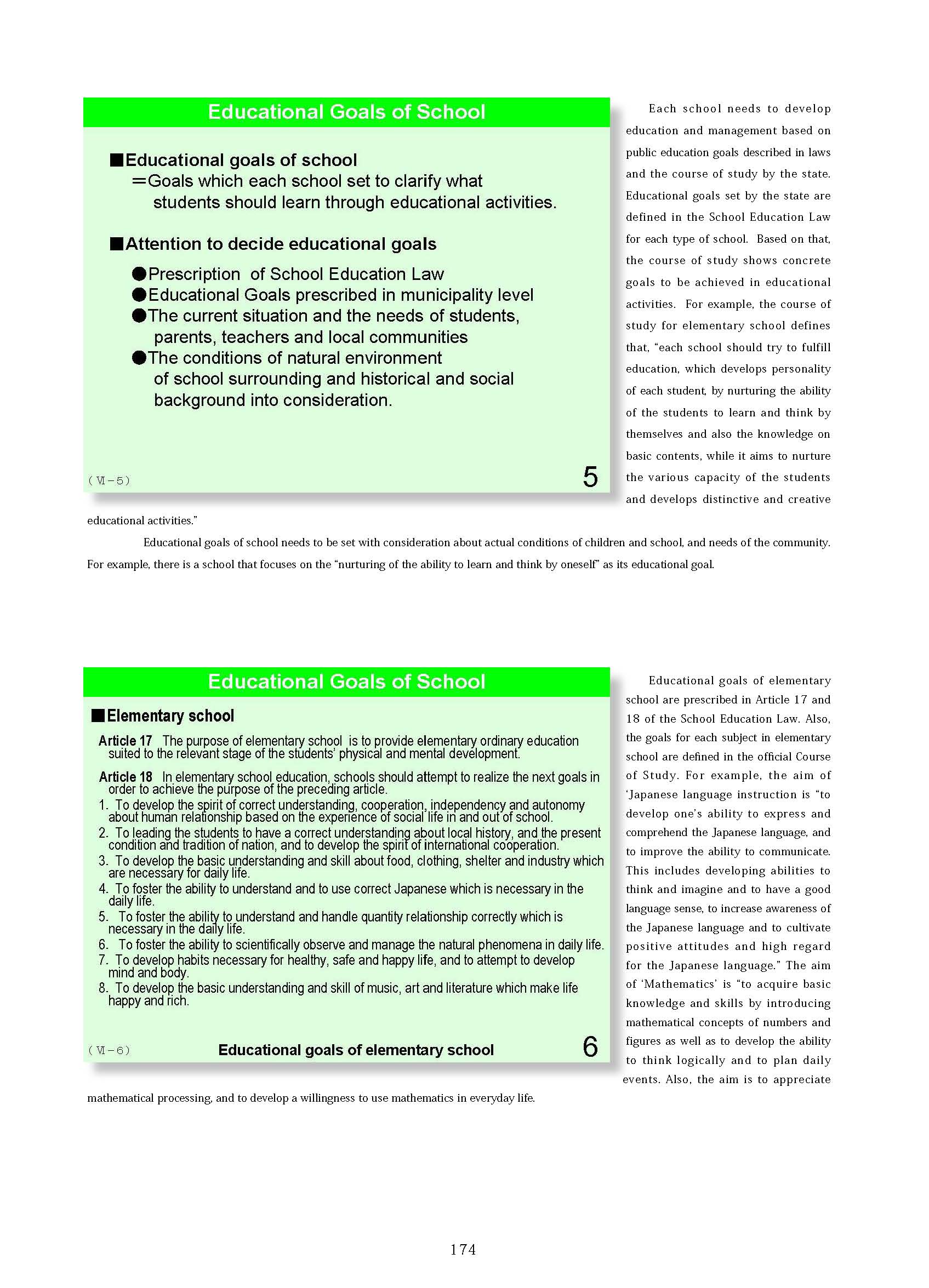 |
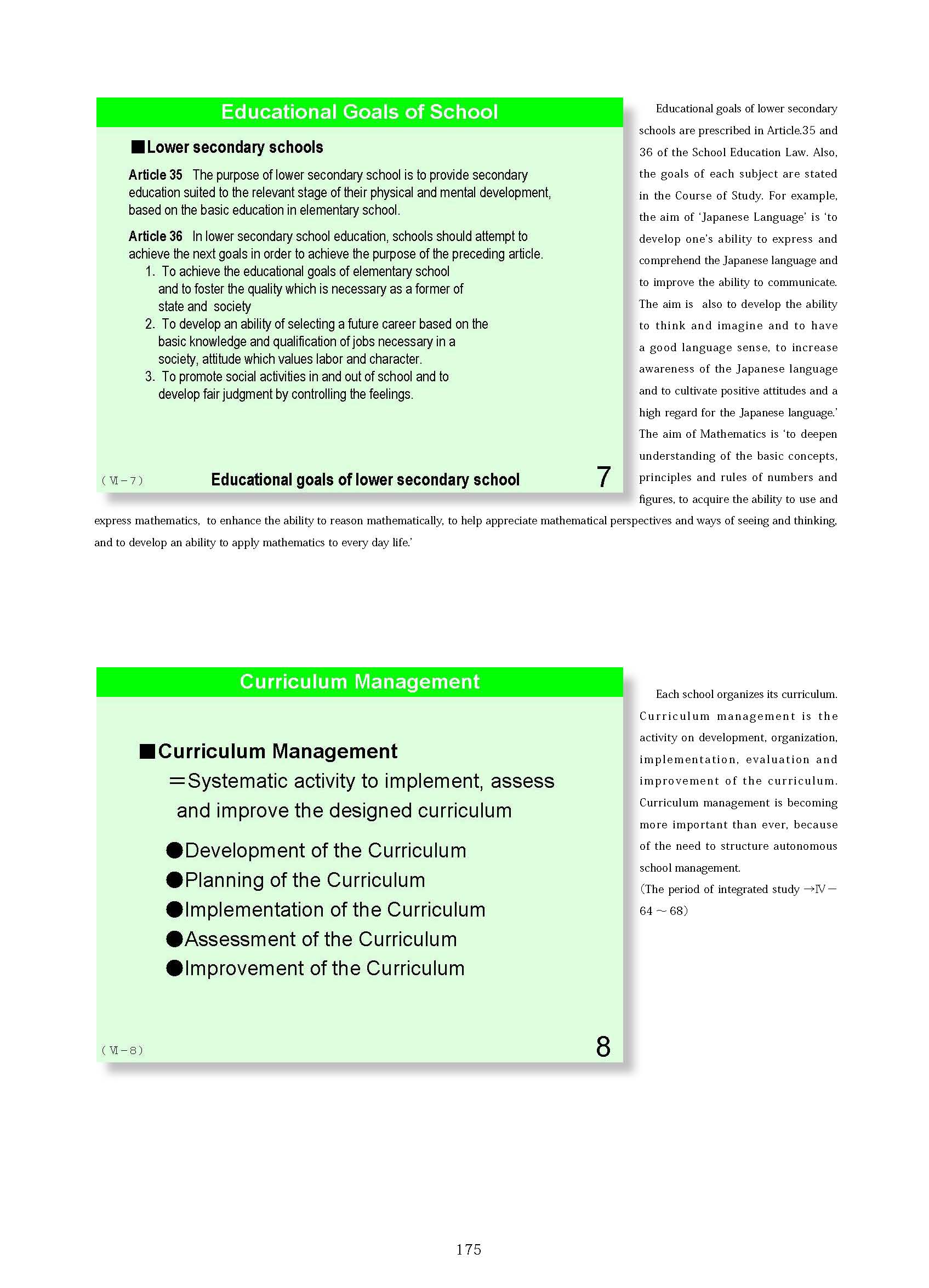 |
Educational goals of lower secondary schools are prescribed in Article.35 and 36 of the School Education Law. Also, the goals of each subject are stated in the Course of Study. For example, the aim of ‘Japanese Language’ is ‘to develop one’s ability to express and comprehend the Japanese language and to improve the ability to communicate. The aim is also to develop the ability to think and imagine and to have a good language sense, to increase awareness of the Japanese language and to cultivate positive attitudes and a high regard for the Japanese language.’ The aim of Mathematics is ‘to deepen understanding of the basic concepts, principles and rules of numbers and figures, to acquire the ability to use and express mathematics, to enhance the ability to reason mathematically, to help appreciate mathematical perspectives and ways of seeing and thinking, and to develop an ability to apply mathematics to every day life.’ | 7 |
| Educational goals of elementary school are prescribed in Article 17 and 18 of the School Education Law. Also, the goals for each subject in elementary school are defined in the official Course of Study. For example, the aim of ‘Japanese language instruction is ‘to develop one’s ability to express and comprehend the Japanese language, and to improve the ability to communicate. This includes developing abilities to think and imagine and to have a good language sense, to increase awareness of the Japanese language and to cultivate positive attitudes and high regard for the Japanese language.’ The aim of ‘Mathematics’ is ‘to acquire basic knowledge and skills by introducing mathematical concepts of numbers and figures as well as to develop the ability to think logically and to plan daily events. Also, the aim is to appreciate mathematical processing, and to develop a willingness to use mathematics in everyday life. |
Each school organizes its curriculum. Curriculum management is the activity on development, organization, implementation, evaluation and improvement of the curriculum. Curriculum management is becoming more important than ever, because of the need to structure autonomous school management. (The period of integrated study →4-64~68) |
||||
| 8 |
Teachers' meeting is the organization that enables teachers to participate in school decision making and it is set at each school. Its institutional roles are: 1.to support duties of principal, 2.to form common understanding on management policy of school, 3.to create opportunities of information exchange and mutual understandings of teachers. In reality, it is considered to be an organization that makes teachers participate in school decision making. There used to be no legal basis for a teachers' meeting. In 2003, in the revision of the enforcement regulation of the School Education Law, a teachers' meeting is defined for the first time. |
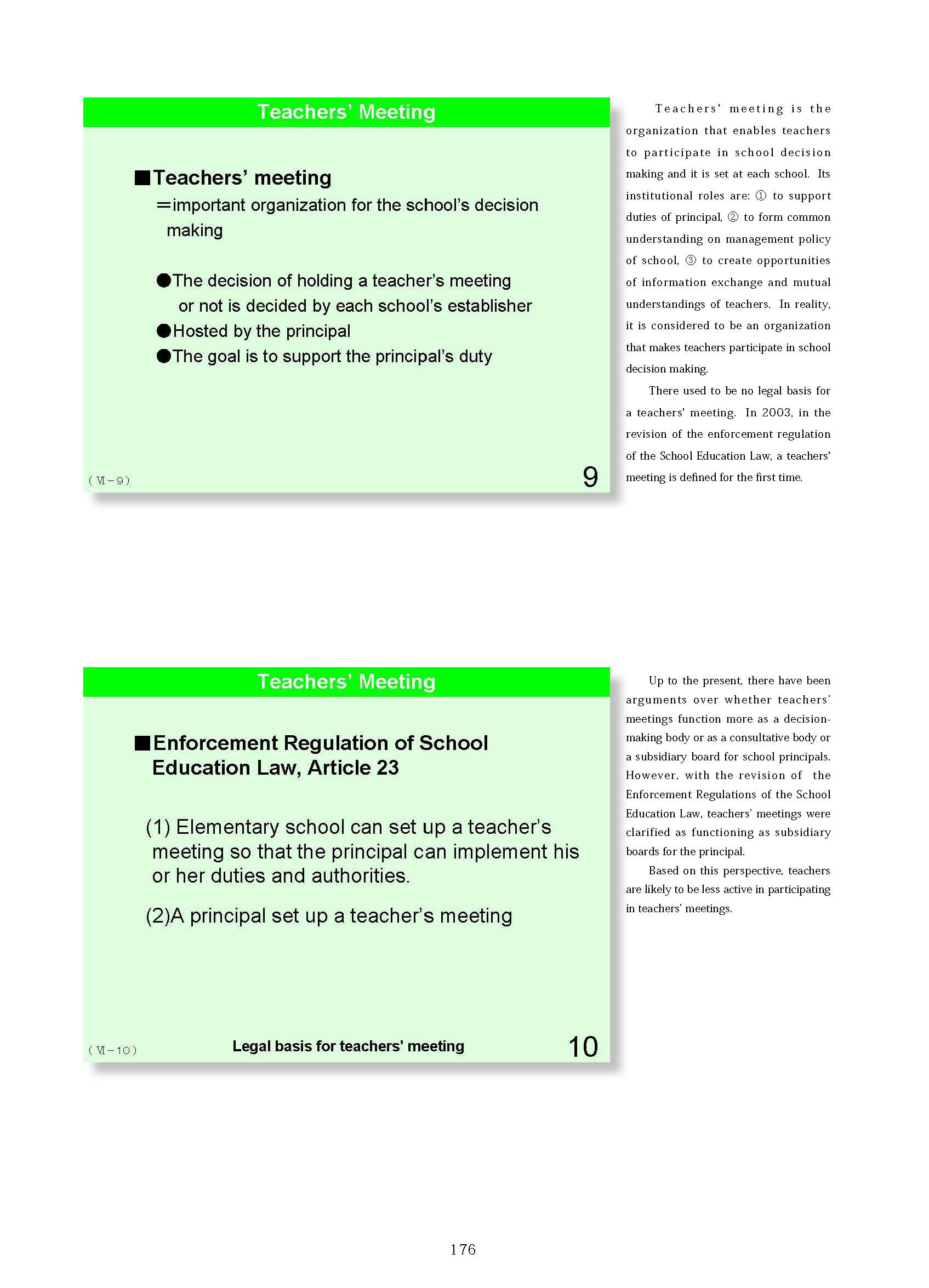 |
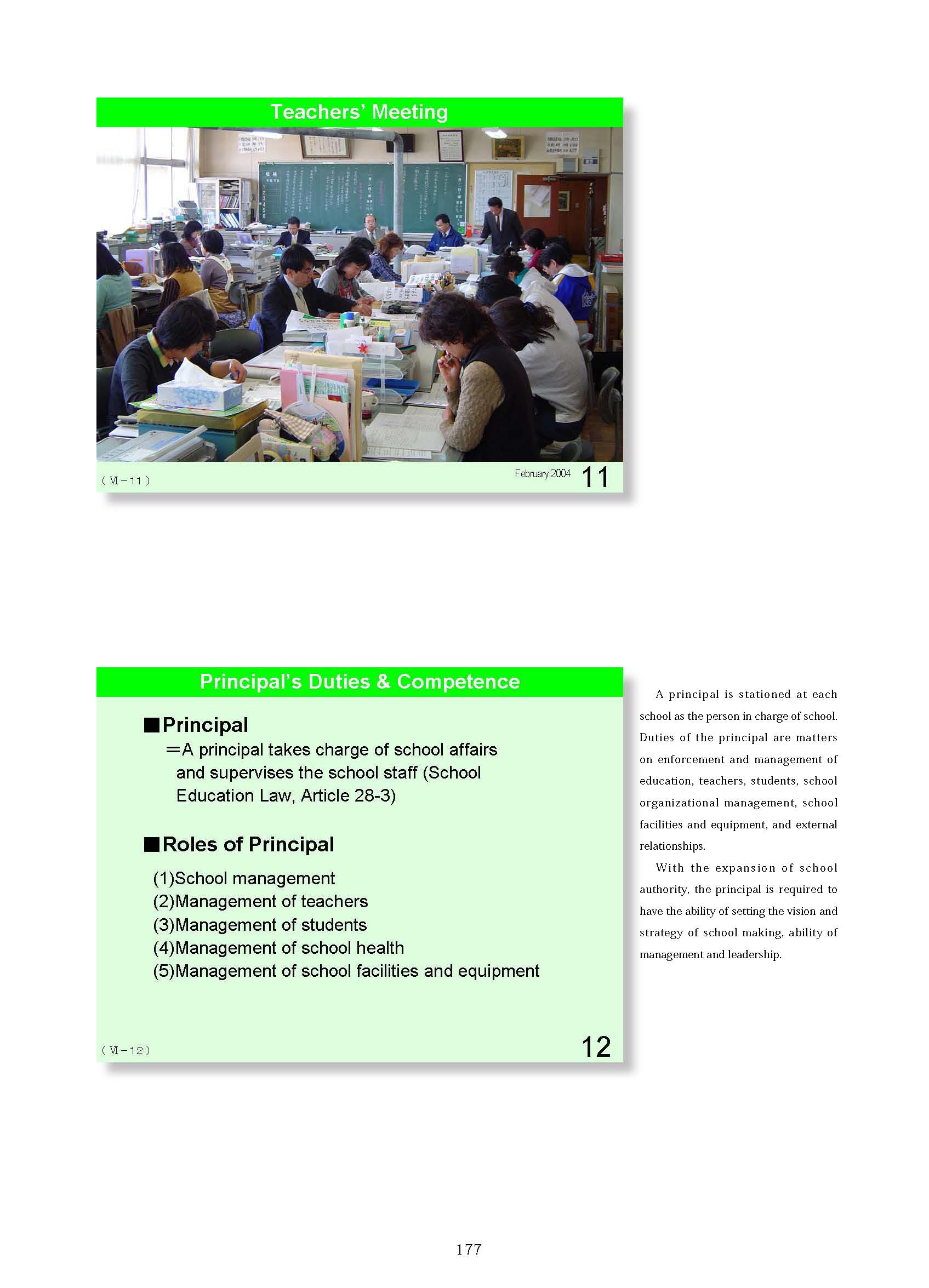 |
9 | |
|
Up to the present, there have been arguments over whether teachers’ meetings function more as a decision-making body or as a consultative body or a subsidiary board for school principals. However, with the revision of the Enforcement Regulations of the School Education Law, teachers’ meetings were clarified as functioning as subsidiary boards for the principal. Based on this perspective, teachers are likely to be less active in participating in teachers’ meetings. |
A principal is stationed at each school as the person in charge of school. Duties of the principal are matters on enforcement and management of education, teachers, students, school organizational management, school facilities and equipment, and external relationships. With the expansion of school authority, the principal is required to have the ability of setting the vision and strategy of school making, ability of management and leadership. |
||||
| 10 | Today, each school seeks emphasize and focus on curricular activities. Schools now have greater local discretion, and local communities are more involved in school management than before. Elevating and upgrading the qualifications required of school principals as school leaders is also a current issue. School leaders who have the capacity to manage school are needed in order to achieve educational goals of individual schools as well as to develop educational activities efficiently by considering alternative options for changes in and out of schools. | 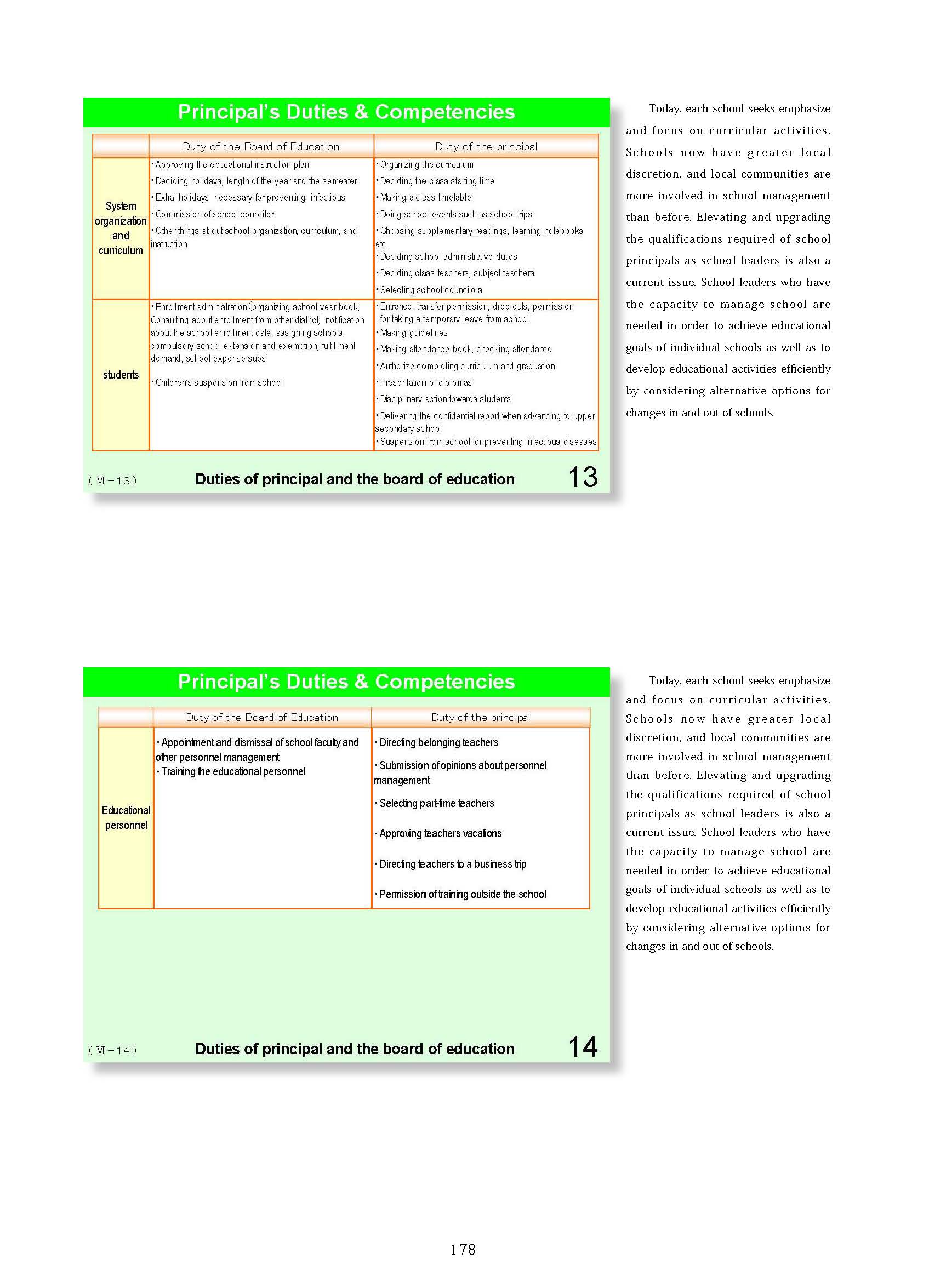 |
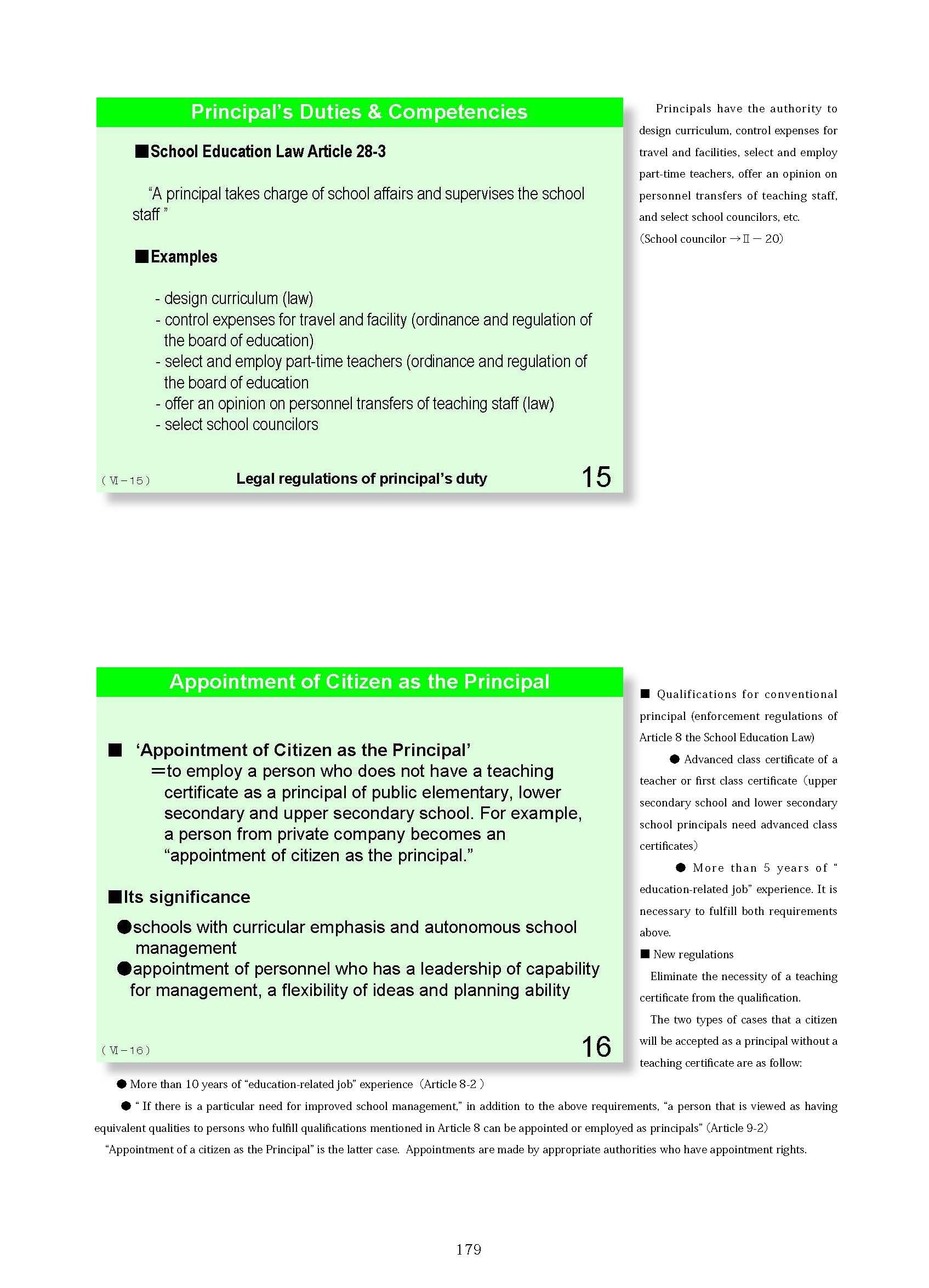 |
Principals have the authority to design curriculum, control expenses for travel and facilities, select and employ part-time teachers, offer an opinion on personnel transfers of teaching staff, and select school councilors, etc. (School councilor →2-20) |
11 |
|
■Qualifications for conventional principal (enforcement regulations of Article 8 the School Education Law) ●Advanced class certificate of a teacher or first class certificate(upper secondary school and lower secondary school principals need advanced class certificates) ●More than 5 years of ‘ education-related job’ experience. It is necessary to fulfill both requirements above. ■ New regulations Eliminate the necessity of a teaching certificate from the qualification. The two types of cases that a citizen will be accepted as a principal without a teaching certificate are as follow: ● More than 10 years of ‘education-related job’ experience(Article 8-2 ) ●‘ If there is a particular need for improved school management,’ in addition to the above requirements, ‘a person that is viewed as having equivalent qualities to persons who fulfill qualifications mentioned in Article 8 can be appointed or employed as principals’ (Article 9-2) ‘Appointment of a citizen as the Principal’ is the latter case. Appointments are made by appropriate authorities who have appointment rights. |
|||||
| 12 |
The number of persons recruited as principals under the ‘Appointment of citizens as Principals’ option has increased rapidly, and by April 2004, were above 50. There is a difference in the purpose and the process of employment and training for ‘citizen principals’ among districts. The training usually takes from 1 to 3 months. However, since many of these principals have little knowledge about education affairs, municipalities typically provide diverse types of training. For example, some municipalities offer practical training regarding current school conditions and relevant educational legislation and require newly recruited principals to visit various schools and interview principals. The purpose of employing non-teachers under the ‘Appointment of citizens as Principals’ option is to utilize their leadership and management to manage ability, their capacity to generate flexible and creative ideas and plans and to use networks that they have acquired through experience in the private sector. Such training needs to be improved to become more effective in order for this alternative ‘appointment of citizens as principals’ option to better achieve its intended goals and objectives. In 2005, there are 79 citizens appointed as principals, and the number seems to be increasing, also besides that 79, there are 13 principals who does not have teacher's certificate. |
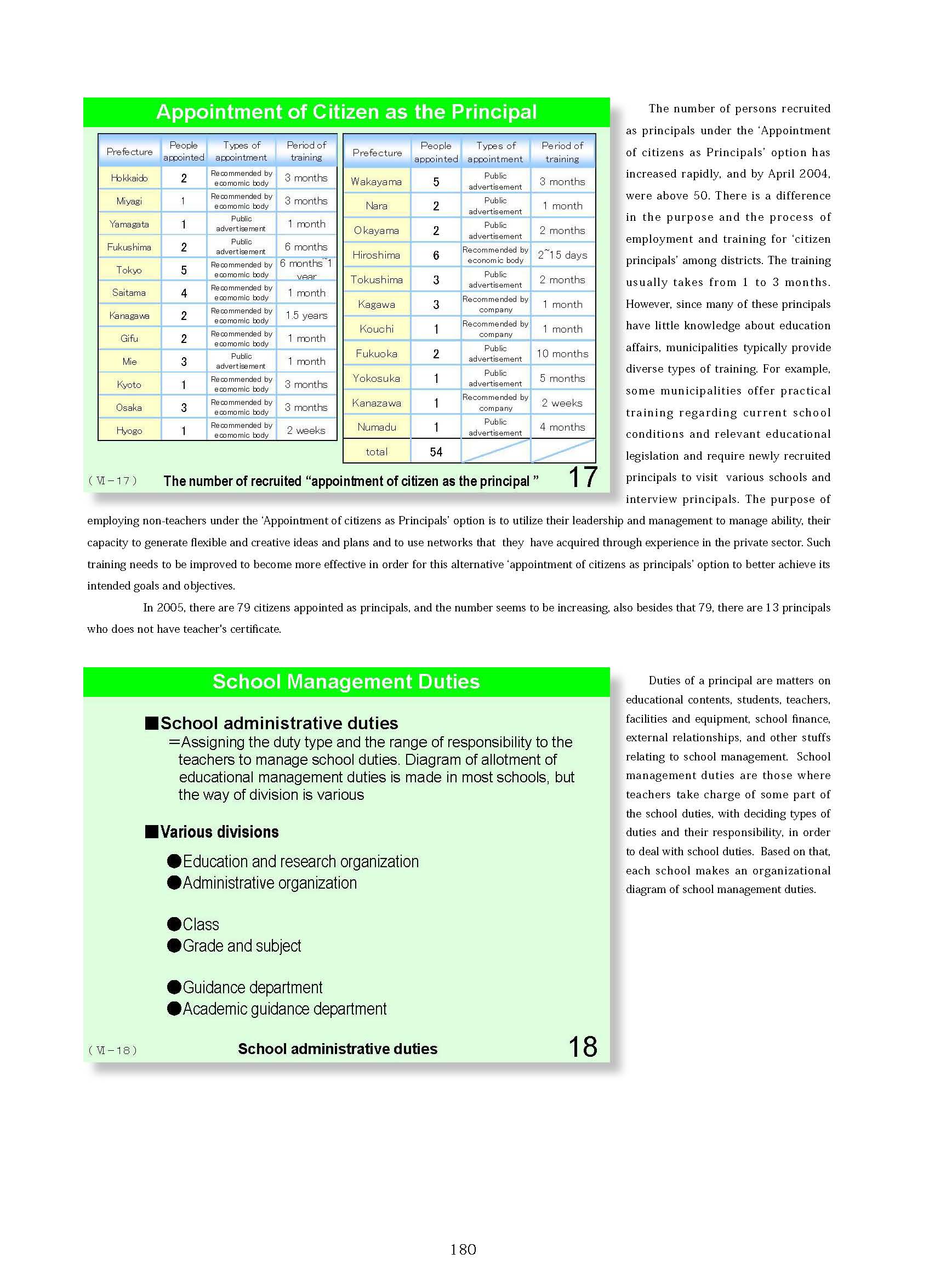 |
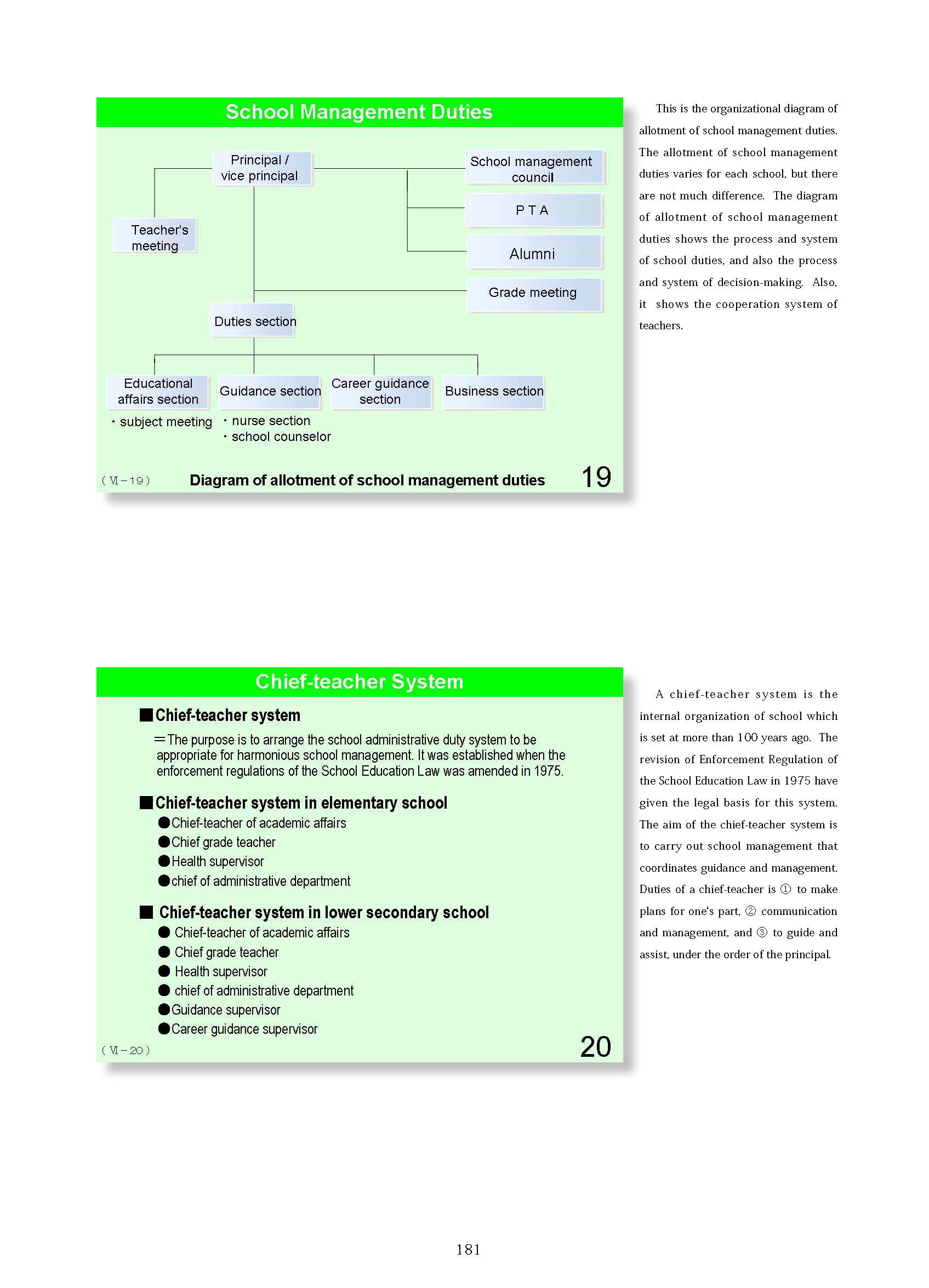 |
This is the organizational diagram of allotment of school management duties. The allotment of school management duties varies for each school, but there are not much difference. The diagram of allotment of school management duties shows the process and system of school duties, and also the process and system of decision-making. Also, it shows the cooperation system of teachers. | 13 |
| Duties of a principal are matters on educational contents, students, teachers, facilities and equipment, school finance, external relationships, and other stuffs relating to school management. School management duties are those where teachers take charge of some part of the school duties, with deciding types of duties and their responsibility, in order to deal with school duties. Based on that, each school makes an organizational diagram of school management duties. | A chief-teacher system is the internal organization of school which is set at more than 100 years ago. The revision of Enforcement Regulation of the School Education Law in 1975 have given the legal basis for this system. The aim of the chief-teacher system is to carry out school management that coordinates guidance and management. Duties of a chief-teacher is 1.to make plans for one's part, 2.communication and management, and 3.to guide and assist, under the order of the principal. | ||||
| 14 |
Duties of each chief-teacher are as: ○ Chief-teacher of school affairs: to negotiate educational plans, class schedules, teaching materials with teachers; to offer training and advice to related staff. ○ Chief-teacher of the grades: to set management principles, plan educational activities, negotiate with and between other homeroom teachers/chief-teachers of other grades/chief-teacher of school affairs/guidance supervisor, and offer training and to provide advice to other home-room teachers. |
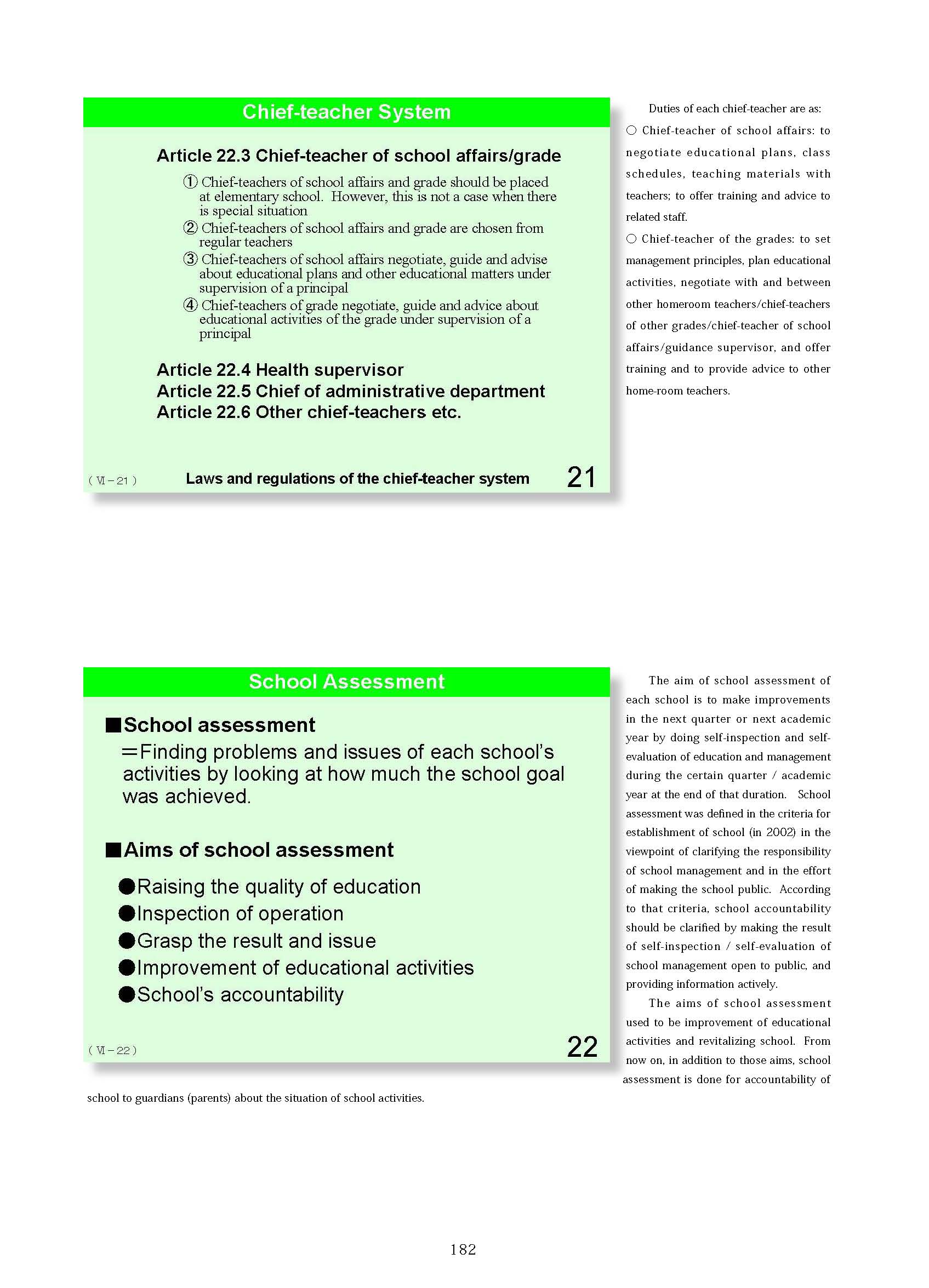 |
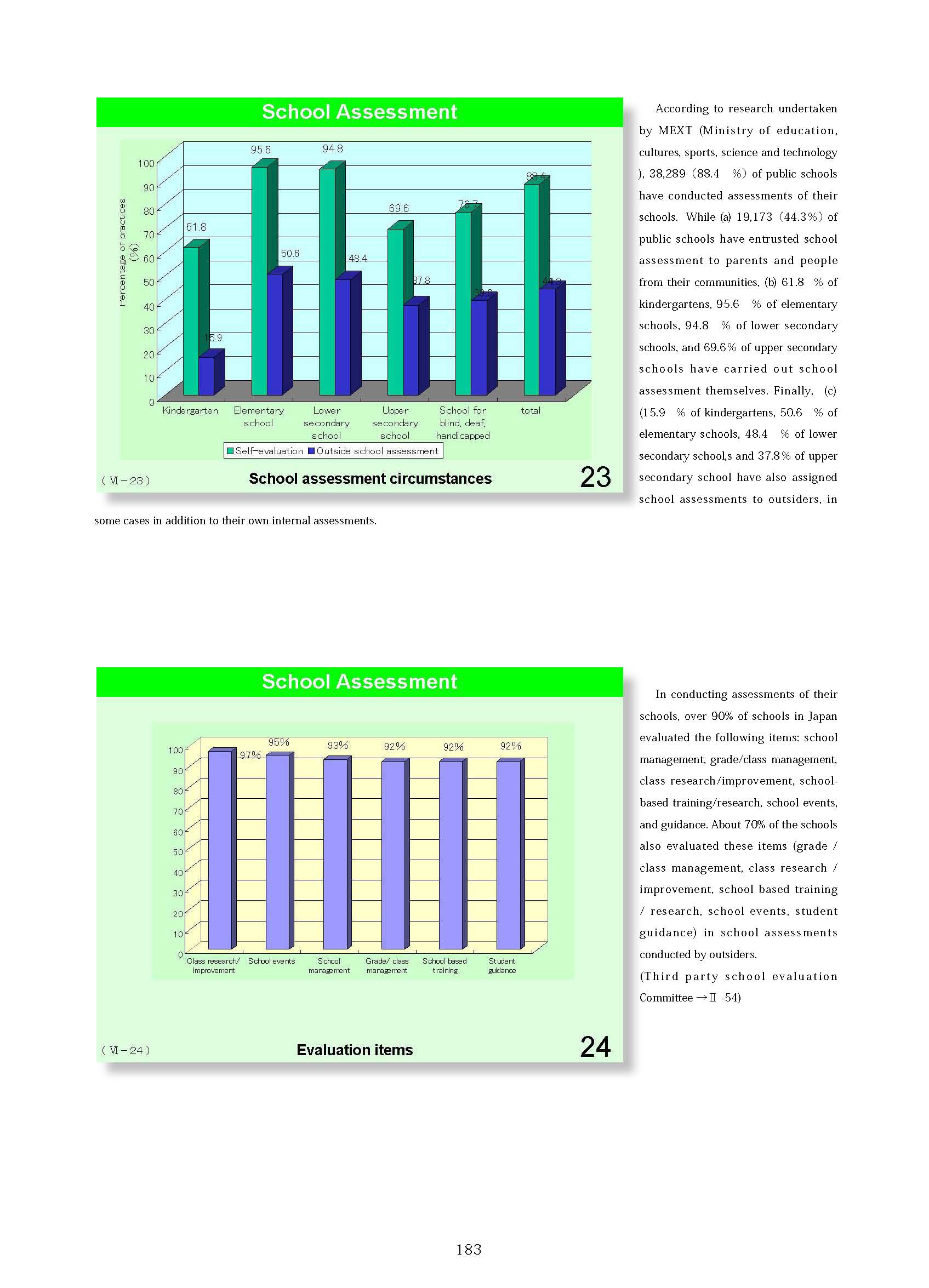 |
According to research undertaken by MEXT (Ministry of education, cultures, sports, science and technology ), 38,289(88.4%) of public schools have conducted assessments of their schools. While (a) 19,173(44.3%) of public schools have entrusted school assessment to parents and people from their communities, (b) 61.8% of kindergartens, 95.6% of elementary schools, 94.8% of lower secondary schools, and 69.6% of upper secondary schools have carried out school assessment themselves. Finally, (c) (15.9% of kindergartens, 50.6% of elementary schools, 48.4% of lower secondary school,s and 37.8% of upper secondary school have also assigned school assessments to outsiders, in some cases in addition to their own internal assessments. | 15 |
|
The aim of school assessment of each school is to make improvements in the next quarter or next academic year by doing self-inspection and self-evaluation of education and management during the certain quarter / academic year at the end of that duration. School assessment was defined in the criteria for establishment of school (in 2002) in the viewpoint of clarifying the responsibility of school management and in the effort of making the school public. According to that criteria, school accountability should be clarified by making the result of self-inspection / self-evaluation of school management open to public, and providing information actively. The aims of school assessment used to be improvement of educational activities and revitalizing school. From now on, in addition to those aims, school assessment is done for accountability of school to guardians (parents) about the situation of school activities. |
In conducting assessments of their schools, over 90% of schools in Japan evaluated the following items: school management, grade/class management, class research/improvement, school-based training/research, school events, and guidance. About 70% of the schools also evaluated these items (grade / class management, class research / improvement, school based training / research, school events, student guidance) in school assessments conducted by outsiders. (Third party school evaluation Committee →2-54) |
||||
| 16 |
In conducting assessments of their schools, over 90% of schools in Japan evaluated the following items: school management, grade/class management, class research/improvement, school-based training/research, school events, and guidance. About 70% of the schools also evaluated these items (grade / class management, class research / improvement, school based training / research, school events, student guidance) in school assessments conducted by outsiders. (Third party school evaluation Committee →2-54) |
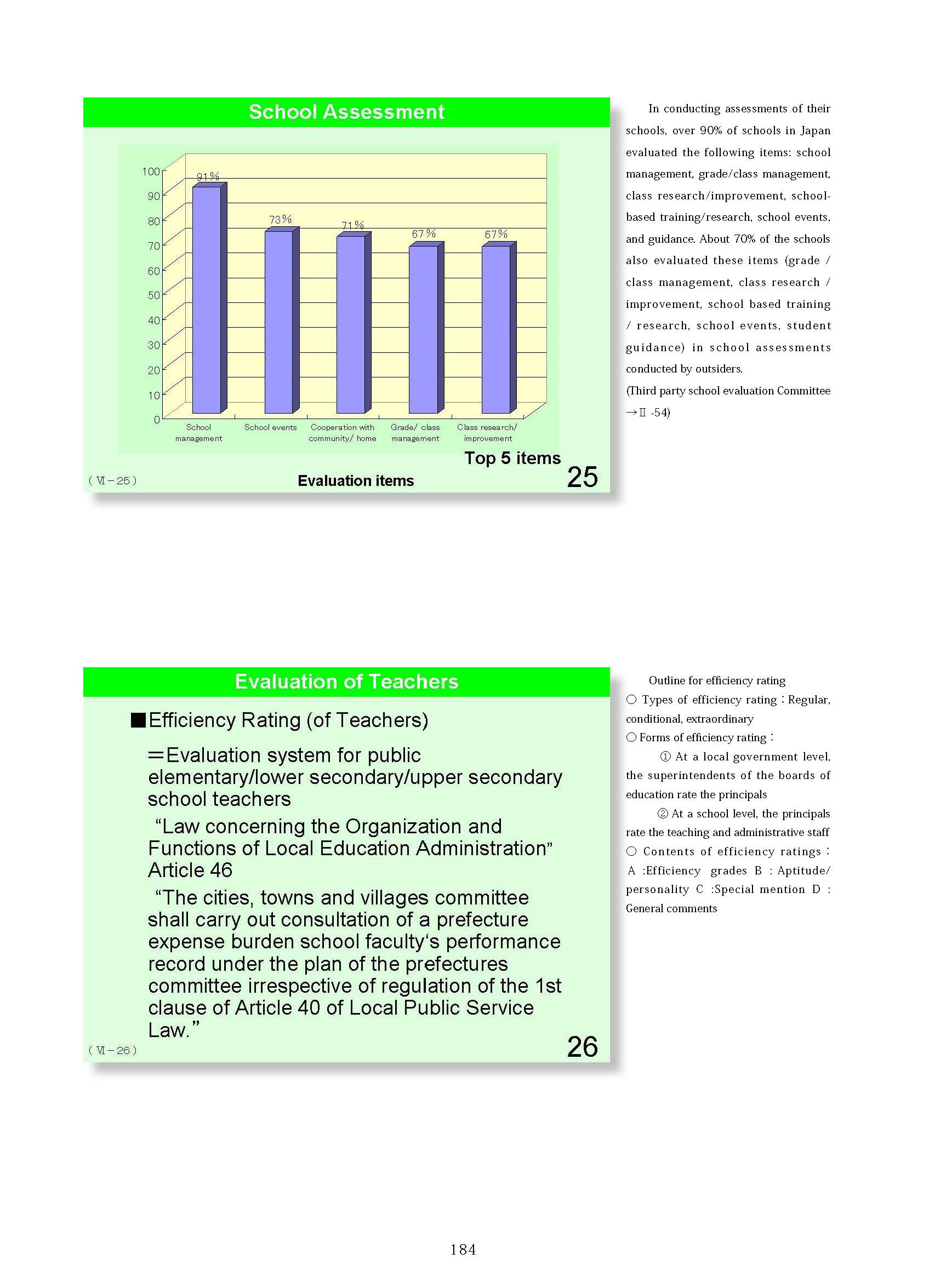 |
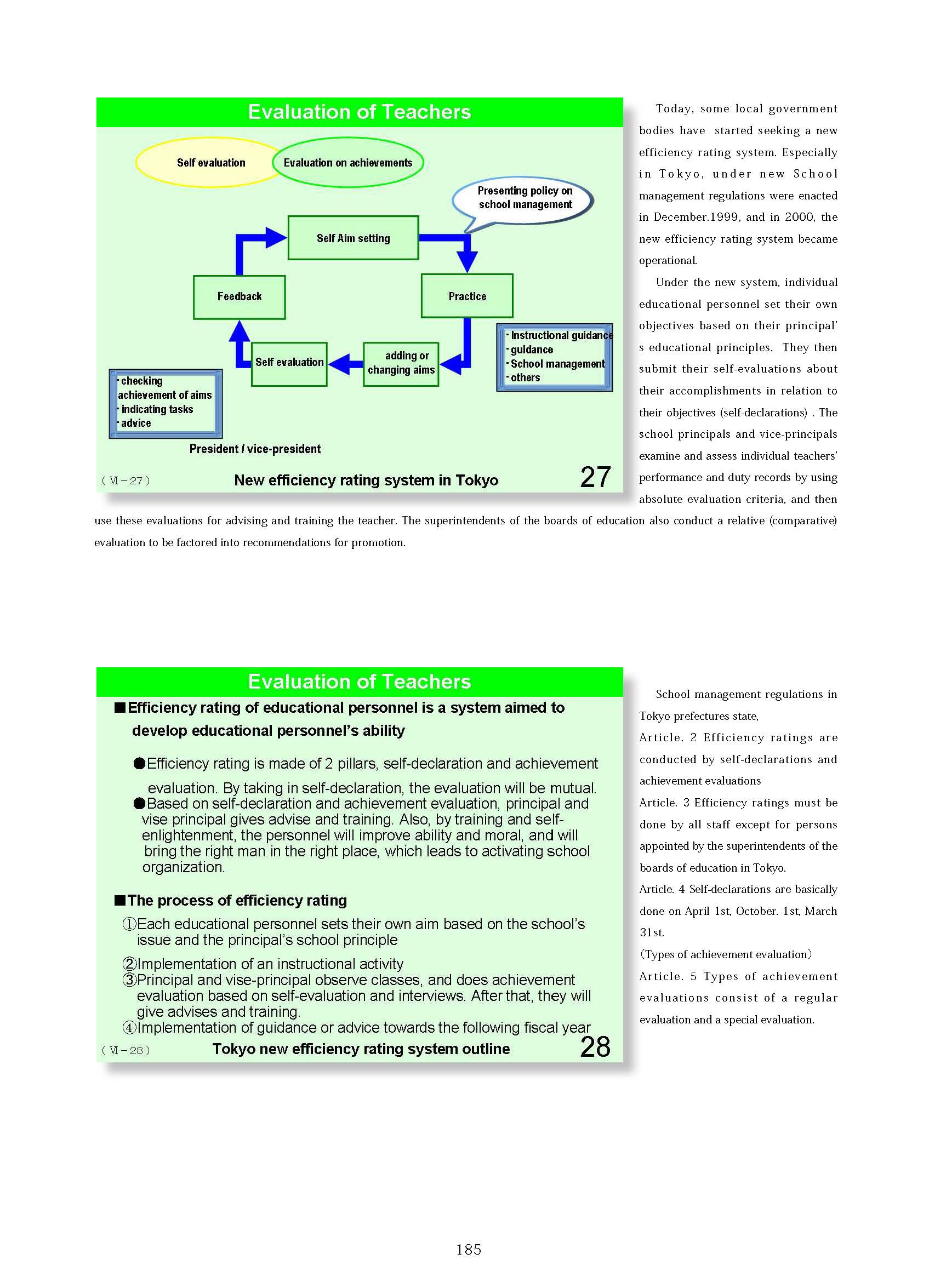 |
Today, some local government bodies have started seeking a new efficiency rating system. Especially in Tokyo, under new School management regulations were enacted in December.1999, and in 2000, the new efficiency rating system became operational. Under the new system, individual educational personnel set their own objectives based on their principal’s educational principles. They then submit their self-evaluations about their accomplishments in relation to their objectives (self-declarations) . The school principals and vice-principals examine and assess individual teachers’ performance and duty records by using absolute evaluation criteria, and then use these evaluations for advising and training the teacher. The superintendents of the boards of education also conduct a relative (comparative) evaluation to be factored into recommendations for promotion. |
17 |
|
Outline for efficiency rating ○Types of efficiency rating:Regular, conditional, extraordinary ○Forms of efficiency rating: 1. At a local government level, the superintendents of the boards of education rate the principals 2. At a school level, the principals rate the teaching and administrative staff ○Contents of efficiency ratings:A:Efficiency grades B: Aptitude/personality C:Special mention D:General comments |
School management regulations in Tokyo prefectures state, Article. 2 Efficiency ratings are conducted by self-declarations and achievement evaluations Article. 3 Efficiency ratings must be done by all staff except for persons appointed by the superintendents of the boards of education in Tokyo. Article. 4 Self-declarations are basically done on April 1st, October. 1st, March 31st. (Types of achievement evaluation) Article. 5 Types of achievement evaluations consist of a regular evaluation and a special evaluation. |
||||
| 18 | There are many risks of natural disasters such as earthquakes and typhoons potentially encountered by students and schools as well as other risks that may occur during school activities and school management. Therefore it is responsibility of schools to ensure the safety of their students. In order to do this, various risks must be assessed, reactions must be anticipated and training in safety management conducted. | 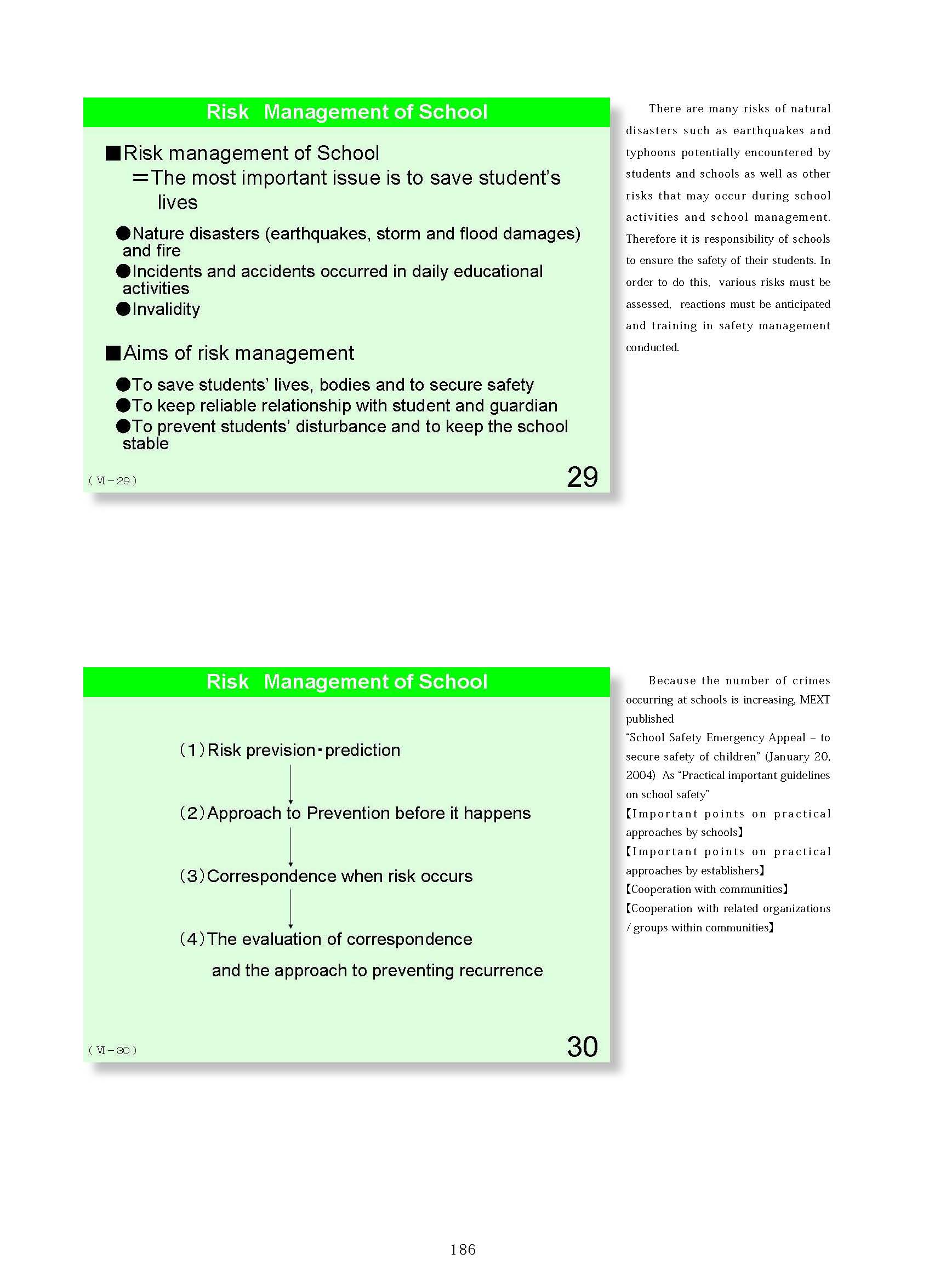 |
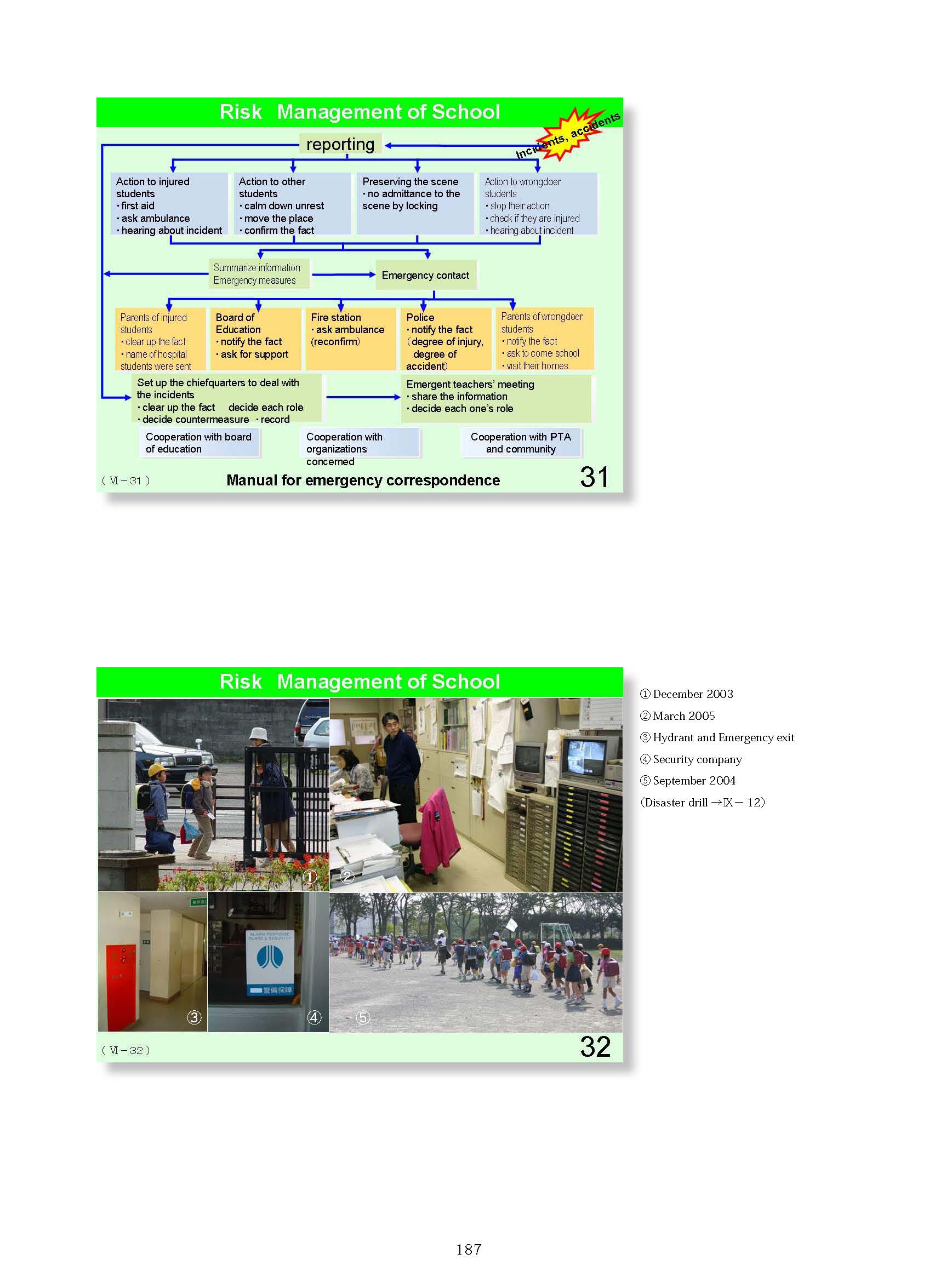 |
19 | |
|
Because the number of crimes occurring at schools is increasing, MEXT published ‘School Safety Emergency Appeal - to secure safety of children’ (January 20, 2004) As ‘Practical important guidelines on school safety’ 【Important points on practical approaches by schools】 【Important points on practical approaches by establishers】 【Cooperation with communities】 【Cooperation with related organizations / groups within communities】 |
1.December 2003 2.March 2005 3.Hydrant and Emergency exit 4.Security company 5.September 2004 (Disaster drill →9-12) |
||||
| 20 |
The Japanese School Choice system was proposed by the National Task Force for Educational Reform third report(1987)and ‘Promotion of Deregulation for Creative Human Development (second) ’ (1996)etc. MEXT (Ministry of education, culture, sports, science and technology) notified the superintendents of each prefectural board of education about the flexibility of school choice in School Districts in 1997, and requested the municipal boards of education to notify parents and local communities. MEXT requested that: 1. Each municipal board of education must consider parental needs 2. Switching schools and attending schools in a different district is permitted based on parental statements 3. Each municipal board of education must distribute the information about school districts and the school choice system, and then prepare an accompanying consulting system to be made available for use by schools, parents of students and communities |
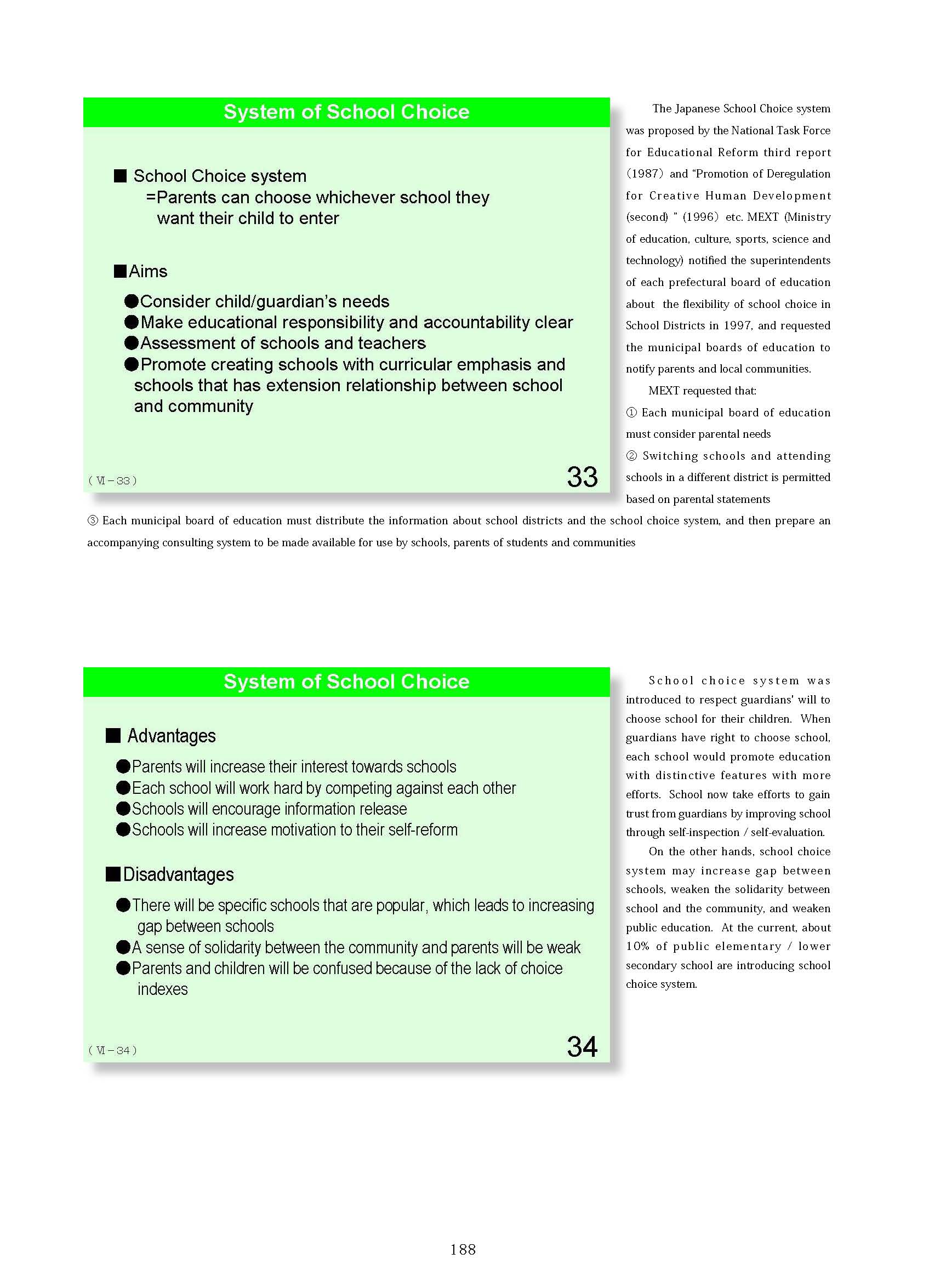 |
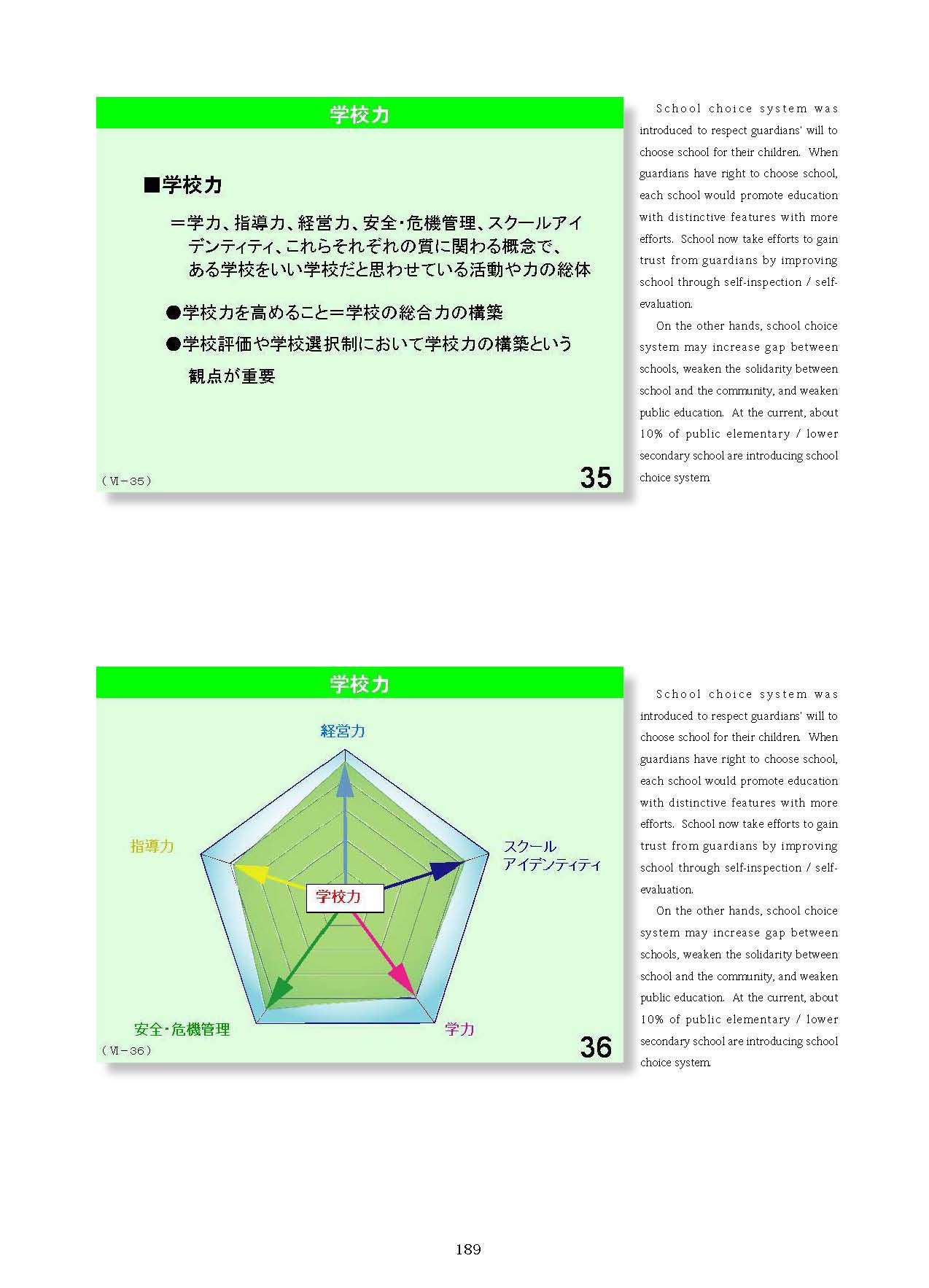 |
School choice system was introduced to respect guardians' will to choose school for their children. When guardians have right to choose school, each school would promote education with distinctive features with more efforts. School now take efforts to gain trust from guardians by improving school through self-inspection / self-evaluation. On the other hands, school choice system may increase gap between schools, weaken the solidarity between school and the community, and weaken public education. At the current, about 10% of public elementary / lower secondary school are introducing school choice system. |
21 |
|
School choice system was introduced to respect guardians' will to choose school for their children. When guardians have right to choose school, each school would promote education with distinctive features with more efforts. School now take efforts to gain trust from guardians by improving school through self-inspection / self-evaluation. On the other hands, school choice system may increase gap between schools, weaken the solidarity between school and the community, and weaken public education. At the current, about 10% of public elementary / lower secondary school are introducing school choice system. |
School choice system was introduced to respect guardians' will to choose school for their children. When guardians have right to choose school, each school would promote education with distinctive features with more efforts. School now take efforts to gain trust from guardians by improving school through self-inspection / self-evaluation. On the other hands, school choice system may increase gap between schools, weaken the solidarity between school and the community, and weaken public education. At the current, about 10% of public elementary / lower secondary school are introducing school choice system. |
||||
| 22 |
School choice system was introduced to respect guardians' will to choose school for their children. When guardians have right to choose school, each school would promote education with distinctive features with more efforts. School now take efforts to gain trust from guardians by improving school through self-inspection / self-evaluation. On the other hands, school choice system may increase gap between schools, weaken the solidarity between school and the community, and weaken public education. At the current, about 10% of public elementary / lower secondary school are introducing school choice system. |
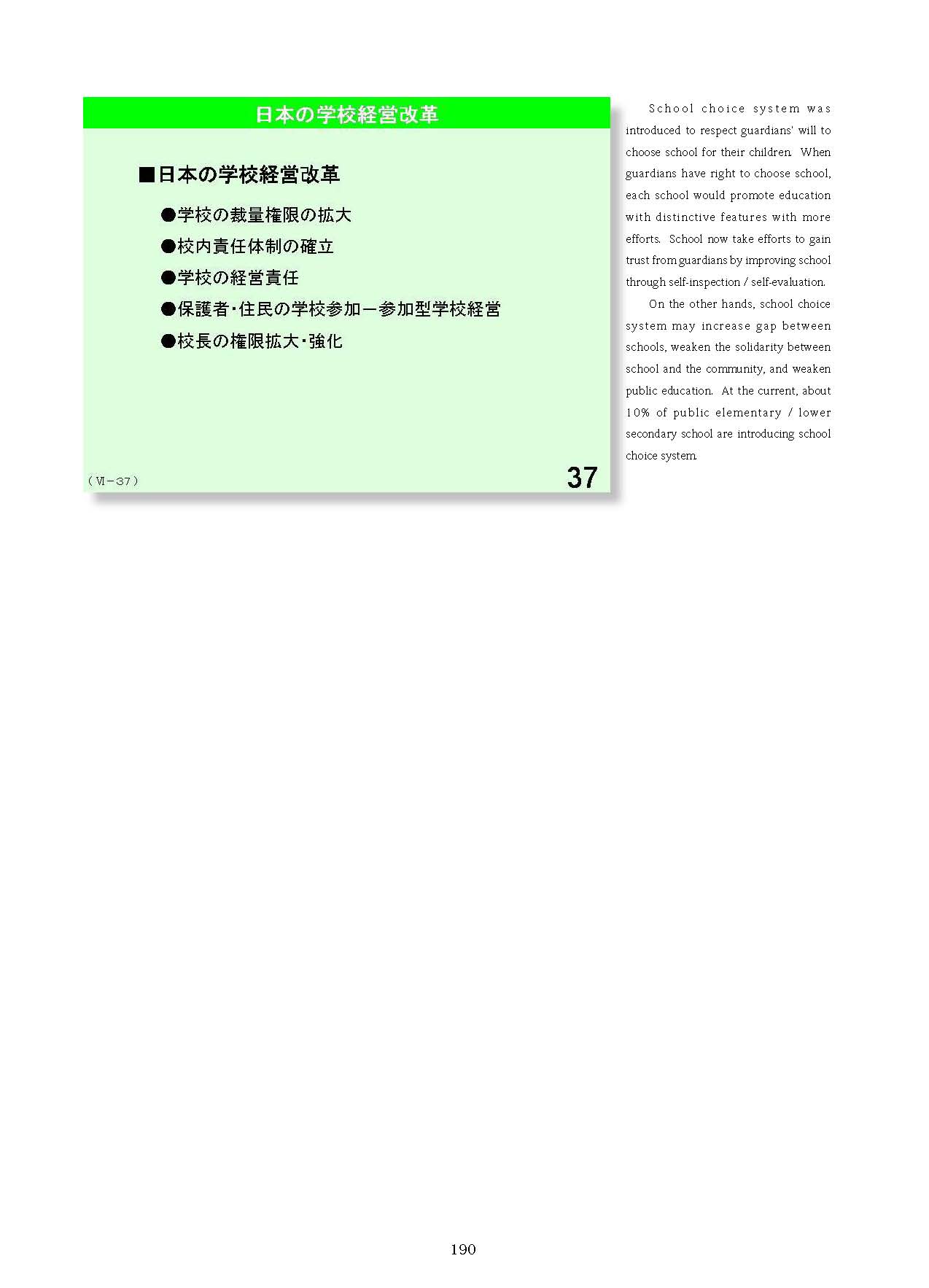 |
23 | ||
| TOP | |||||
Please send your comments and concerns here
kamada@criced.tsukuba.ac.jp
Center for Research on International Cooperation in Educational Development (CRICED) University of Tsukuba
1-1-1, Tennodai, Tsukuba-shi, IBARAKI
305-8572 JAPAN